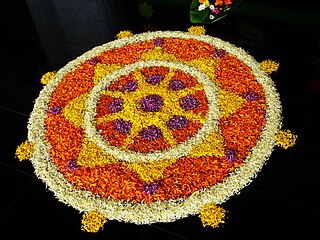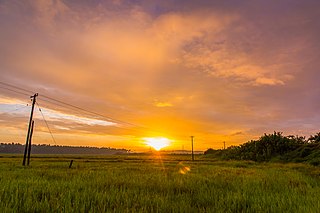
Onam is an annual Indian harvest festival celebrated predominantly by the Hindus of Kerala. A major annual event for Keralites, it is the official festival of the state and includes a spectrum of cultural events.

Poorakkali is a traditional dance ritual performed by men during the nine-day Pooram festival in Bhagavathy temples across North Malabar in Kerala State of south India.

Vadakkumnathan Temple is an ancient Hindu temple dedicated to Shiva at city of Thrissur, of Kerala state in India. This temple is a classical example of the architectural style of Kerala and has one monumental tower on each of the four sides in addition to a kuttambalam. Mural paintings depicting various scenes from the Mahabharata can be seen inside the temple. The shrines and the Kuttambalam display vignettes carved in wood. The temple, along with the mural paintings, has been declared as a National Monument by India under the AMASR Act. According to popular local lore, this is the first temple built by Parasurama, the sixth avatara of Vishnu. Thekkinkadu Maidan, encircling the Vadakkumnathan Temple, is the main venue of the renowned Thrissur Pooram festival.
Azhakodi Devi Temple is a Hindu temple in Thiruthiyadu, Thiruthiyadu, Kozhikode, Kerala, India. It is about 1.5 km away from the Mofussil bus stand and 2.5 km from the KSRTC Bus stand in the Kozhikode city.

Bhadrakali, also known as Mahakali and Kali, is a Hindu goddess.
Azhvanchery Thamprakkal or Azhvanchery Samrāṭ is the title of the senior-most male member of the Nambudiri Brahmin feudal lords of Azhvanchery Mana in Athavanad, Kerala, South India. They had the right over Guruvayur, and were the titular head of all Nambudiri Brahmins of Kerala. The Lord of Azhvanchery based at Athavanad and the Lord of Kalpakanchery based at neighbouring Kalpakanchery were usually present at the coronation of a new Zamorin of Kozhikode. Kalpakanchery Thamprakkals were related to the Nambudiris of Panniyoor while Azhvanchery Thamprakkals to those of Chowwara.

Cherpu is a suburb of Thrissur city in the Kerala State of South India. It is 12 kilometres south of Thrissur town and is on the Thriprayar road. It is dotted by a number of temples and has quite a few rivers flowing by its vicinity.

Thrissur, is one of the 14 districts in the Indian state of Kerala. It is situated in the central part the state. Spanning an area of about 3,032 km2 (1,171 sq mi), Thrissur district is home to over 9% of Kerala's population.

Mudiyettu is a traditional ritual theatre and folk dance drama from Kerala that enacts the mythological tale of a battle between the goddess Kali and the demon Darika. The ritual is a part of the bhagavathi or bhadrakali cult. The dance is performed in bhadrakali temples, the temples of the Mother Goddess, between February and May after the harvesting season.

Thirumandhamkunnu Temple is a historically significant Hindu temple in Angadipuram, which was the capital of Valluvanad Rajavamsham, in Malappuram district, Kerala state, South India. The temple deity, Thirumandhamkunnil amma, was the paradevatha of the kings of Valluvanad, the local feudal kings ruled the area in the Middle Ages. The Nair warriors of Valluvanad king set out from this temple to Thirunavaya, to participate in the famous Mamankam festival. A memorial structure called the chaver thara can be found in front of the main entrance of the Thirumanthamkunnu Temple.

Manapullikavu is a Hindu temple located in Palakkad city, Kerala of India. The temple is most famous for the annual festival that takes place in the temple known as Manappullikavu Vela. Manapullikavu is also a major residential area in Palakkad city comprising apartments and residential colonies. Manappulikavu is ward 27 of Palakkad Municipality.
Padur (or Padoor) is a village in Palakkad District, Kerala. There is a temple of Sree Panickanar where a yearly festival called Padur Vela is celebrated, which is the curtain raiser for Vela-Poorams in Palakkad.

Kummattikali or Kummatti Kali is the famous colorful mask-dance of Kerala, prevalent in Thrissur District, Palakkad District and parts of South Malabar. During the festival of Onam, Kummattikali performers move from house to house collecting small gifts and entertaining people. Kummatti dances are rampant in the Thrissur district during Onam. Pristine or original form of Kummattikali can be seen in the Bhadrakali temple in Palakkad district. Kerala

The Sree Vaikom Mahadeva Temple is a temple dedicated to the Hindu god Shiva in Vaikom, Kerala, India. The temple, along with the Ettumanoor Shiva Temple and the Kaduthuruthy Shiva Temple is considered a powerful place of Shiva. The belief is that if a devotee worships all the three temples before the Ucha puja, all his/her wishes are fulfilled. It is one of the oldest temples in Kerala and is famous for its Vaikom Ashtami festival.

Thiruvathira or Thiruvathirai or Arudhra Darisanam is a Hindu festival celebrated in the Indian states of Kerala and Tamil Nadu. Thiruvathirai (Arudhra) in Tamil means "sacred big wave". In Chidambaram in Tamil Nadu, the Sri Natarajar temple's annual Festival, is celebrated on this date. In the month of Makaram Thiruvathira Star is celebrated in Mathira Peedika Devi Temple, owned by Thiruvithamcore Devaswom Board, near Kadakkal in Kollam District of Kerala state. Thiruvathira has a connection with lord moon.
Thiruvathirakali is a unique group dance of women in Kerala. The dance is performed by women in small groups, both as part of and apart from religious rituals. Generally on Onam and Thiruvathira day in the month of Dhanumas, women perform this art form by singing the praises of Shiva Parvati in Shiva temples etc. Tiruvathirakali is considered a must especially for women who observe Thiruvathira vradam. This art form is also known as Kaikottikali and Kummikali with slight variations. This dance is believed to bring a long and auspicious married life and marriage of choice. This play is performed at night on Thiruvathira day. The first Thiruvathira after the marriage of girls is called Poothiruvathira.
The Panniyur Sri Varahamurthy Temple is an ancient Hindu temple complex situated at Kumbidi, Pattambi taluk, Palakkad district of Kerala, India. This Temple is believed to be the first temple in Kerala consecrated by Parasurama nearly 4000 years ago. The temple houses Lord Varahamoorthy, who is the third avatar of Lord Vishnu, who is positioned with Goddess Bhumi after killing Hiranyaksha.

Kilimarathukavu Siva Parvathy Temple is a Hindu temple located in Kadakkal, Kollam, Kerala, India. It contains the largest cult image of 'Dharma Sastha', an epithet of Ayyappan.

Avanangattilkalari Sree Vishnumaya Temple is a Hindu temple at Peringottukara, Thrissur District, Kerala state, India. It is dedicated to the god Vishnumaya in Kerala. The god is known also by the names Chathan.
Malavazhiyattam also known as MalavayiyattamKariniliyattam or Cheruniliyattam is a ritualistic folk art of the Paraya community in Kerala, India. Malavazhi is a mother goddesses installed in the homes of the Parayas and worshiped by them. Malavazhiyattam or Cheruniliyattam is performed to please the deities through music and drama.
![coolllikllikkunnkuttttik[?].JPG](http://upload.wikimedia.org/wikipedia/commons/thumb/a/a1/%E0%B4%9A%E0%B5%8B%E0%B4%B4%E0%B4%BF%E0%B4%95%E0%B4%B3%E0%B4%BF%E0%B4%95%E0%B5%8D%E0%B4%95%E0%B5%81%E0%B4%A8%E0%B5%8D%E0%B4%A8%E0%B4%95%E0%B5%81%E0%B4%9F%E0%B5%8D%E0%B4%9F%E0%B4%BF%E0%B4%95%E0%B5%BE.JPG/220px-%E0%B4%9A%E0%B5%8B%E0%B4%B4%E0%B4%BF%E0%B4%95%E0%B4%B3%E0%B4%BF%E0%B4%95%E0%B5%8D%E0%B4%95%E0%B5%81%E0%B4%A8%E0%B5%8D%E0%B4%A8%E0%B4%95%E0%B5%81%E0%B4%9F%E0%B5%8D%E0%B4%9F%E0%B4%BF%E0%B4%95%E0%B5%BE.JPG)













